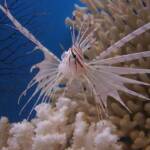


DANGER
WANTED
Lionfish
What a Sting can Bring!
Danger Surrounding the Venomous Lionfish Sting
The venomous tips on the lionfish fins present a danger to people who swim, dive or work in our South Florida waters. Their sting burns like fire and lasts for about 15 to 20 minutes. The lionfish sting is so serious that it can send victims to the hospital and even kill them.
The lionfish is one of the most venomous fish on the ocean floor ranking second only to stingrays in the total number of stingings worldwide, with an estimated 40,000-50,000 cases annually. Lionfish have venomous dorsal spines that are used purely for defense, and when threatened the fish often faces its attacker in an upside down posture which brings its spines to bear. However, the lionfish sting is usually not fatal to humans. If a person is stung, that person will experience intense throbbing, sharp pain, tingling sensations, sweatiness and blistering. In worst case scenarios the symptoms may include headache, nausea, abdominal pain, delirium, seizures, paralysis of limbs, changes in blood pressure, breathing difficulties, heart failure and tremors, pulmonary edema, and loss of consciousness. A common treatment is soaking the afflicted area in hot water, as there is currently no anti-venom. However, immediate emergency medical treatment is still advised as some people are more susceptible to the venom than others.
Pre-Hospital Care:
The treatment for a lionfish sting is the gentle removal of any visible spines, and apply direct pressure to control the bleeding. Lionfish venom contains proteins that are denatured by heat thus preventing them from spreading in the bloodstream, so hot water immersion technique is often used. Heat treatment is widely recommended as an effective initial treatment for envenomations by Scorpaenidae as well as echinoderms, stingrays, and other venomous spine injuries. Immerse the affected part in hot water for about 30 minutes. If hot water is not available, aspirin, or aspirin with codeine can be taken. (Do not use hot water and aspirin together.) Be sure to look for signs of serious systemic symptoms and upon recognition be ready for the prompt institution of appropriate life-saving procedures such as cardiopulmonary resuscitation (CPR) and treatment for anaphylaxis. The recognition of these symptoms is paramount in a prehospital care setting, then transport for a definitive medical evaluation.
Emergency Department Care:
Emergency department (ED) management of Scorpaenidae envenomations involves addressing the venom exposure as well as the accompanying inflicted trauma. General rules of therapy include prompt analgesia, wound management, anti-venom administration, and supportive treatment for significant envenomations. CPR and advanced cardiac life support (ACLS) procedures are rarely needed, but always take absolute precedence.
Wound debridement, or removal of dead, damaged, or infected tissue, and the gentle manual removal of obviously protruding spines prevent further penetration or breakage. With proper anesthesia, surgical removal of embedded spines is indicated when they are in proximity to joints, nerves, or vessels. Weight-bearing surfaces may require removal of spines to prevent chronic pain. Always irrigate generously after adequate anesthesia. The affected limb should be immersed in water no warmer than 114 degrees fahrenheit, or 45 degrees celsius. Be careful not to inflict thermal burns by placing an insensate limb (as a result of local anesthesia or decreased sensitivity as a result of pain) into scalding water. Local or regional anesthesia, if available, may be necessary.
Website Designed by Tami Beckel for Vone Research, Inc. © 2010. Vone Research is a 501(c)3, non profit organization.
Please report broken links to the Webmaster

